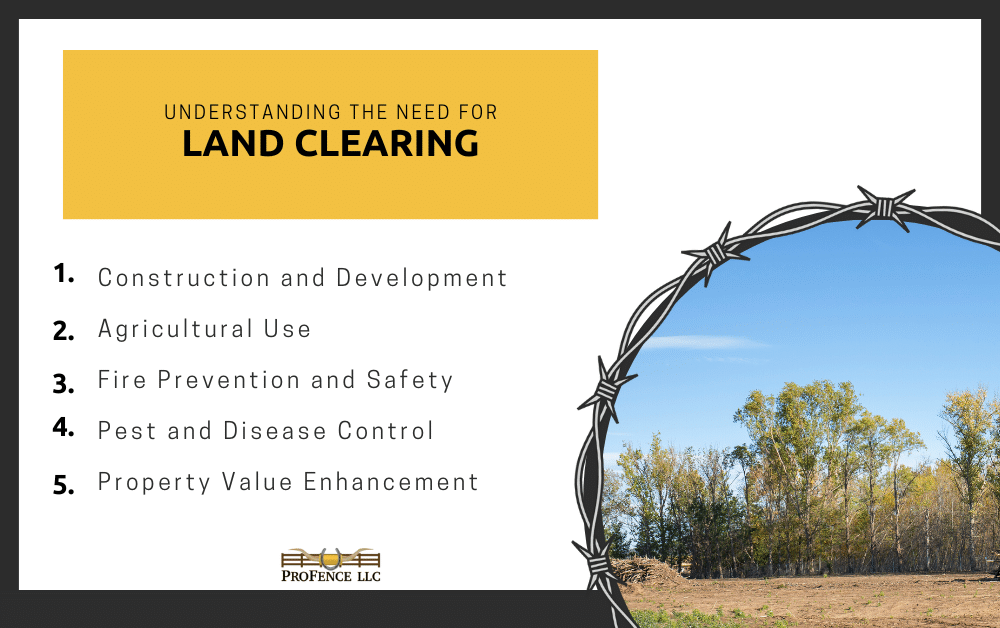Land clearing enables property owners to turn untamed land into organized, functional spaces. Whether for building, farming, or safety, this essential service paves the way for growth, security, and better land use. Without land clearing, many development and agricultural projects would face significant delays and complications. This process is not just about removing trees and brush—it’s about preparing land for new purposes and protecting the environment. If you’re looking for expert help with land clearing, ProFence offers professional, efficient, and reliable services tailored to your property’s needs. Here, we take a closer look at why people may need land clearing, from construction projects to increasing property value.
Construction and Development
Preparing Land for Homes and Buildings
When undertaking the construction of a residential or commercial project, the first step is often clearing the land. Trees, brush, and rocks must be removed to create a safe, flat surface where foundations can be laid. This step is crucial for ensuring that the construction process starts on solid ground. Without land clearing, builders could encounter unstable soil, hidden obstacles, or safety hazards. The process also helps in mapping out the layout of utilities, roads, and structures for efficient development. Overall, land clearing is essential to turning vision into reality on any construction site.
Infrastructure Projects Require Open Space
Large-scale infrastructure projects such as highways, public facilities, or utility installations demand open and accessible land. Clearing the area of vegetation, rocks, and debris ensures a stable and buildable environment. This not only improves the safety of the construction zone but also enhances the quality and durability of the finished project. A well-cleared site helps engineers and contractors ensure smoother progress and reduce the likelihood of costly interruptions. Proper land clearing also allows heavy equipment to operate safely and effectively. For any infrastructure effort, cleared land is a non-negotiable starting point.
Enhancing Project Timelines and Budgets
Delays caused by uncleared land can significantly impact construction schedules and budgets. When unexpected obstacles like large stumps, boulders, or uneven terrain are discovered late in the process, they can drive up costs and slow down work. By clearing the land early, developers can better forecast project timelines and reduce the likelihood of financial overruns. Efficient land clearing services make it easier to adhere to deadlines, especially when multiple contractors are involved. It also improves coordination among different teams on-site. In the long run, this preparation can save both time and money.
Agricultural Use
Creating Room for Crops
Farmers rely on open, fertile land to grow crops efficiently and sustainably. Land clearing removes unwanted vegetation and debris, providing the space needed for plowing, planting, and irrigation. Without proper clearing, machinery can become damaged or ineffective, reducing productivity. Additionally, clearing helps expose the soil to sunlight and air, which are crucial for plant growth. It also makes it easier to monitor crops and manage weeds and pests. For any successful farming operation, cleared land lies the foundation for high yields and efficient use of resources.
Expanding Livestock Grazing Areas
Livestock require large, open pastures for grazing, movement, and rest. Overgrown land can pose a danger to animals by hiding predators or containing harmful plants. Land clearing creates safer, more accessible grazing zones that support the health and well-being of the herd. It also enables the installation of fencing, shelters, and water systems tailored to livestock needs. By opening up more land, farmers can expand their operations and better manage animal rotation for soil recovery. Properly cleared pastures lead to healthier animals and improved productivity.
Supporting New Farming Operations
New agricultural ventures, whether small-scale or industrial, often begin with land clearing. Starting with a clean slate helps eliminate invasive plant species and ensures the area is suitable for cultivation. This also allows for accurate land assessment, which guides decisions about what crops or animals the land can best support. Entrepreneurs in the farming industry benefit from the increased control and flexibility that cleared land provides. With fewer natural obstacles, it’s easier to design efficient layouts for fields, barns, and irrigation systems. Land clearing is a key first step in transforming ideas into thriving agricultural businesses.
Fire Prevention and Safety
Reducing Fire Hazards in Dry Climates
In environments characterized by prolonged heat and limited rainfall, overgrown vegetation becomes a serious fire hazard. Dead branches, dry grass, and dense brush can easily ignite, especially during wildfire season. Land clearing reduces the amount of combustible material, lowering the risk of fires spreading quickly. It creates safe zones that can slow or stop the path of a fire before it reaches homes or critical infrastructure. This is especially important for rural or forested properties. Regular land clearing is a proactive approach to fire safety and community protection.
Creating Defensible Space Around Properties
One of the most effective ways to protect property from wildfires is to implement defensible space around the property for fire resistance. This involves clearing a buffer zone around buildings where vegetation and other fuel sources are minimized. Defensible space allows emergency responders to work more effectively and gives fire less of a chance to reach structures. Land clearing makes it possible to maintain this space and meet local safety standards. Homeowners who live in wildfire-prone areas are often required to maintain these clear zones. Taking this step can make the difference between saving and losing a property during a fire event.
Complying with Local Fire Safety Regulations
Many local governments enforce fire safety codes that mandate land clearing on specific properties. These regulations are designed to protect communities from large-scale fire events and to make firefighting efforts more effective. Property owners must clear brush, maintain firebreaks, and ensure accessibility for emergency vehicles. Disregarding these rules may subject you to legal and monetary repercussions, not to mention increased danger to people and property. Professional land clearing services help ensure compliance and peace of mind. It’s an investment in both personal safety and community wellbeing.
Pest and Disease Control
Eliminating Habitats for Pests
Overgrown land provides ideal shelter for pests like termites, rodents, snakes, and other unwanted critters. Such pests are capable of endangering health and damaging structures, equipment, or crops. Land clearing eliminates dense brush and fallen trees where pests like to nest, reducing their populations and deterring infestations. This is especially important near residential or commercial buildings. A clean, open landscape is far less attractive to invasive species. Keeping land clear is a simple yet effective strategy for long-term pest control.
Preventing the Spread of Plant Diseases
Unmanaged land can harbor plant diseases that threaten surrounding crops and native vegetation. Dead or diseased trees can infect nearby plants, especially when humidity and poor air circulation are present. Land clearing removes infected growth and improves airflow, helping reduce the spread of harmful fungi and bacteria. This is particularly important for farms, orchards, and gardens where plant health is essential. Clearing land regularly allows for easier inspection and treatment of problem areas. In the long term, it supports a healthier and more resilient landscape.
Supporting Healthier Ecosystems
While land clearing removes certain elements of the natural environment, it can also help restore balance. Clearing invasive species and overgrowth allows native plants and animals to thrive. This creates a more sustainable and diverse ecosystem over time. Additionally, properly managed clearing can improve soil health, reduce erosion, and promote water retention. Landowners who clear with care can create a cleaner, safer, and more ecologically stable environment. With the right approach, land clearing becomes a tool for both human use and environmental restoration.
Property Value Enhancement
Making Land More Appealing to Buyers
First impressions matter, especially in real estate. Overgrown or cluttered land can discourage potential buyers, while a well-cleared property appears maintained and ready for use. Land clearing improves curb appeal and helps prospective buyers see the full potential of the space. This visual clarity can lead to quicker sales and higher offers. It facilitates marketing efforts by real estate professionals to market the property more effectively. Whether selling privately or through a listing, cleared land offers a competitive edge.
Increasing Usable Land Space
Cleared land gives property owners more options for use and development. Without trees, brush, or debris in the way, it becomes easier to add features like driveways, garages, or gardens. This expanded usability increases the practical value of the land, making it more functional for current and future needs. Homeowners can better enjoy their outdoor spaces, while businesses gain room for expansion or operations. Land that is fully usable is generally more valuable and versatile. A well-cleared plot is an asset with broad potential.
Boosting Marketability for Investors
Real estate buyers with investment goals often prioritize properties that require minimal work before development. Land clearing removes one of the major barriers to investment by making the property ready for immediate planning or construction. Investors are more likely to pursue opportunities that save time and reduce risk. Cleared land presents a blank canvas that can be tailored to a variety of commercial or residential projects. In competitive markets, cleared lots stand out and sell faster. For landowners seeking investment interest, land clearing is a strategic move.
Conclusion
Whether you’re building a home, starting a farm, protecting against wildfires, or simply improving the market value of your land, land clearing is often the critical first step. It’s more than just cleaning up—it’s aimed at realizing the complete capabilities of your land and establishing a safe, usable, and valuable space. With professional services like those offered by Pro Fence, the process is efficient, environmentally conscious, and tailored to your unique goals. Land clearing supports long-term planning, from private projects to public infrastructure, while also addressing safety and environmental health. Don’t let overgrowth stand in your way—partner with a team you can trust.
Ready to unlock your land’s full potential? Contact Pro Fence today to schedule expert land clearing services and start your next project on solid ground.







